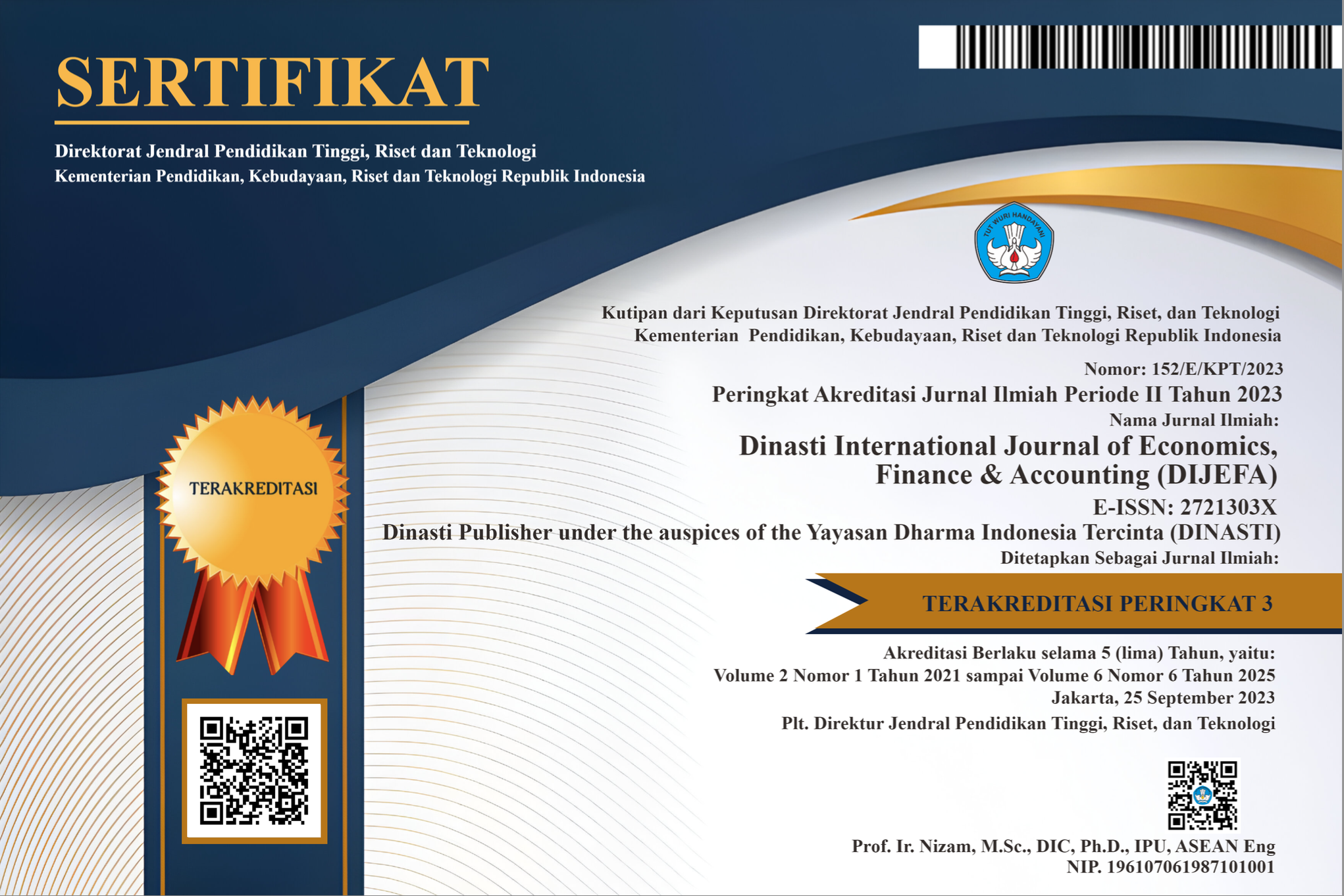Green Building as a Strategy for Operational Cost Reduction and Customer Satisfaction
DOI:
https://doi.org/10.38035/dijefa.v6i2.4198Keywords:
Green Building, Operational Cost Reduction, Energy Efficiency, Customer SatisfactionAbstract
Research Objective: To determine the relationship between Green Building and Strategy Operational Cost Reduction and Customer Satisfaction. Research Type: Quantitative research with a descriptive analysis approach. Findings: Green building is an approach that is increasingly being adopted by many organizations as a primary strategy in reducing operational costs while increasing customer satisfaction. This strategy focuses on efficient use of resources, reducing environmental impacts, and creating a better customer experience. Green building integrates energy-efficient and environmentally friendly technologies and designs, Customer satisfaction is one of the important benefits of implementing green buildings. Customers are now increasingly aware of the importance of sustainability and tend to choose companies that care about the environment; a close relationship between reducing operational costs and customer satisfaction through the implementation of green buildings. Theoretical Contribution/Originality: Implementation of green buildings to increase customer satisfaction with cost reduction strategies Practitioner/policy Implications: Green building is an approach that is increasingly being adopted by many organizations as a primary strategy in reducing operational costs while increasing customer satisfaction. Research Limitation/Implications: This article offers a green building concept with a Strategy for Operational Cost Reduction to increase Customer Satisfaction.
References
Ahzahar, S. Z. B. Hashim, I. B. Bin Zakaria, N. N. M. Noor, and N. A. B. A. Rahman, “Identification of Barriers and Challenges Faced by Construction Key Players in Implementing the Green Building Incentives in Malaysia,” vol. 26, pp. 209– 218, 2022, doi: 10.1108/s2040-726220220000026016.
Akhir, P. Studi, T. Sipil, F. Teknik, and U. Udayana, “Analisis Penerapan Green Building,” vol. 9, no. 2, pp. 1–19, 2015.
Anjomshoa, “The application of building information modeling (BIM) system in the smartification of green and sustainable buildings,” Eng. Constr. Archit. Manag., 2024, doi: 10.1108/ECAM-03-2024-0291.
Anzagira, E. Badu, E. K. Simpeh, A. B. Marful, and S. Amos-abanyie, “Structural equation modelling of the critical barriers in fl uencing the adoption of green building concepts and technologies in Ghana,” vol. 1, no. 1, pp. 229–259, doi: 10.1108/JRPC-11-2023-0019.
Ariana, N. Azizah, and M. Y. Ariana, “Exploring dimensions of customer satisfaction : An analysis of determinant factors in the experience of consuming AG Food,” J. Manag. Sci., vol. 7, no. 2, pp. 284–289, 2024.
Elkington, John (1998), Cannibals With Forks: The Triple Bottom Line in 21st. Century Business, Gabriola Island, BC: New Society Publishers
Fan and X. Li, “Exploring effective incentive policies for sustainable development of green buildings in China: based on evolutionary game theory and numerical simulation analysis,” Eng. Constr. Archit. Manag., 2024, doi: 10.1108/ECAM- 06- 2023-0622.
Green Building Council Indonesia (GBCI). (2011). Greenshipexisting building version 1.0 ringkasan tolok ukur. Divisi Rating Dan Teknologi GBCI, 1– 15. Retrieved from www.gbcindonesia.org
Hashim, N. B. Ahzahar, I. B. Bin Zakaria, and N. N. M. Noor, “Introducing New Parameter in Green Building Incentives to Enhance Sustainable Development Paradigm in Malaysia,” vol. 26, pp. 37–44, 2022, doi: 10.1108/s2040- 726220220000026004.
Kiki, B. M. T. Samosir, E. Murwaningsari, and Y. Augustine, “The benefit of green building for cost efficiency,” Int. J. Financ. Accounting, Manag., vol. 1, no. 4, pp. 209–219, 2020, doi: 10.35912/ijfam.v1i4.152.
La Roche, P., & Berardi, U. (2014). Comfort and energy savings with active green roofs. Energy and Buildings. https://doi.org/10.1016/j.enbuild.2014.07.05
Trihudiyatmanto and I. Larasati, “Green Satisfaction: Relationship of Green Brand Image to Green Brand Equity,” Proc. 3rd Borobudur Int. Symp. Humanit. Soc. Sci. 2021 (BIS-HSS 2021), pp. 569–573, 2023, doi: 10.2991/978-2-494069 49-7_94.
Vyas, G. S., & Jha, K. N. (2019). Benchmarking green building attributes to achieve cost effectiveness using a data envelopment analysis. Sustainable Cities and Society, 28, 127–134. https://doi.org/10.1016/j.scs.2016.08.028Yoshida, J., Onishi, J., & Shimizu, C. (2018). Energyefficiency and green building markets inJapan. SSRN Electronic Journal, 1–24. https://doi.org/10.2139/ssrn.2844040
Wang, Z. Shen, and Y. Zhou, “Rapid Control of Government Economic Environment Management Cost Based on Balanced Score Card,” J. Environ. Public Health, vol. 2022, 2022, doi: 10.1155/2022/8506676.
Wicaksono, “Pengaruh Biaya Lingkungan, Kinerja Lingkungan, dan Kepemilikan Asing Terhadap Kinerja Keuangan Perusahaan,” Ekon. Keuangan, Investasi dan Syariah, vol. 5, no. 4, pp. 627–635, 2024, doi: 10.47065/ekuitas.v5i4.5066.
Yulia, D. Adawiyah, and Y. Ardiany, “Pengaruh Penerapan Akuntansi Manajemen Lingkungan dan Strategi Operasional Terhadap Biaya Pengelolaan Limbah di RSIA Siti Hawa,” Ekasakti Pareso J. Akunt., vol. 1, no. 1, pp. 72–79, 2023, doi: 10.31933/epja.v1i1.806.
Downloads
Published
How to Cite
Issue
Section
License
Copyright (c) 2025 Arsid, Karsam, Atik Budi Paryanti, Ulil Fadilah

This work is licensed under a Creative Commons Attribution 4.0 International License.
Authors who publish their manuscripts in this journal agree to the following conditions:
- The copyright on each article belongs to the author(s).
- The author acknowledges that the Dinasti International Journal of Economics, Finance & Accounting (DIJEFA) has the right to be the first to publish with a Creative Commons Attribution 4.0 International license (Attribution 4.0 International (CC BY 4.0).
- Authors can submit articles separately, arrange for the non-exclusive distribution of manuscripts that have been published in this journal into other versions (e.g., sent to the author's institutional repository, publication into books, etc.), by acknowledging that the manuscript has been published for the first time in the Dinasti International Journal of Economics, Finance & Accounting (DIJEFA).


























































